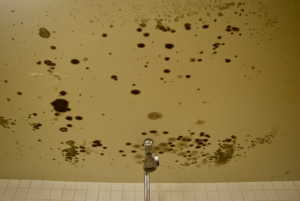The Office of Planning and Facilities Management is responding to a significant increase in student concerns about mold by cleaning dorms with high rates of moisture-related problems, as universities nationwide address mold infestation in campus buildings.
Between Dec. 21 and Jan. 9, facilities conducted cleanings and inspections of on-campus buildings that were exposed to high amounts of moisture and mold last semester, according to Benjamin Kuo, vice president of planning and facilities management.

“We conducted deep cleaning of all private bathrooms in our residence halls, on-campus apartments and off-campus townhouses, as well as larger communal bathrooms in the dormitories, approximately 920 bathrooms total,” Kuo wrote in an email to The Hoya.
In addition, 148 bathrooms received extra cleaning to ensure that tile and grout areas were free of mold, according to Kuo.
Facilities responded to 361 mold-related work requests between August and October last year, more than double the number reported during that time frame in 2017.
All the bathrooms of Village A and Henle Village apartments were treated with Saniglaze, a sealing process to clean and maintain tile and grout, according to an email sent to the Georgetown community members Wednesday.
The university also hired outside contractors to inspect the dorms with increased reports of moisture and mold build-up, according to Kuo. Eastern Research Group, an industrial hygienist firm, searched for mold and measured air conditions in affected dorms.
Addressing reports of mold is a university priority and students are encouraged to contact the Student Health Center should they have any concerns about mold affecting their health, according to Geoffrey Chatas, Georgetown senior vice president and chief operating officer.
“We will continue to monitor the situation and respond to recommendations from ERG’s final report to ensure a safe learning, working and living environment for our campus community,” Chatas wrote in the Wednesday email.
Historic amounts of rainfall contributed to increased mold in on-campus dorms, with the greatest number of requests coming from students living in Village C, Darnall Hall and Village A.
Several students became ill after exposure to black mold in their dormitories last semester. Students reported contracting bronchitis, as well as experiencing difficulty breathing, coughing, lightheadedness, fatigue and congestion. Exposure to mold can lead to itchy eyes and skin, upper respiratory problems and nasal stuffiness, according to the Center for Disease Control.
Facilities conducted air quality assessments in Village C East, Village C West and Darnall Hall before winter break, according to a Dec. 3 email sent to residents of the three dorms. Facilities staff conducted visual inspections of each student dormitory room as well as the common rooms.
Members of the Georgetown Solidarity Committee urged the university to protect facilities workers responsible for the removal and cleanup of mold in a letter delivered to University President John J. DeGioia on Dec. 6. Workers were exposed to harsh chemical cleaners such as bleach during mold remediation efforts, often without proper training, according to GSC.
Other colleges in the Washington, D.C. area have also experienced issues with mold because of unprecedented amounts of rainfall and poorly maintained buildings.
Last September, more than 500 students at the University of Maryland, College Park, were relocated to hotels after mold was discovered throughout a freshman dorm. Incidents of mold in living areas have also been reported at nearby universities, including American University and The George Washington University.
The increase in reports of mold is not limited to colleges in the region: Indiana University at Bloomington is among many universities nationwide that experienced an increase in mold-related problems last semester, according to the Indiana Daily Student. IU is facing a class action lawsuit that alleges the university did not do enough to remove mold in two freshman dorms.




















